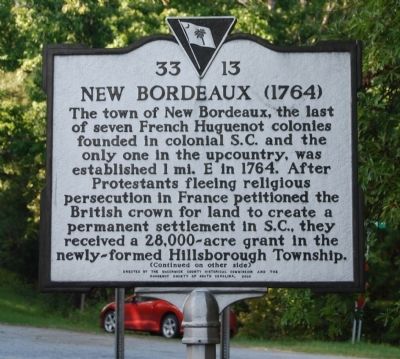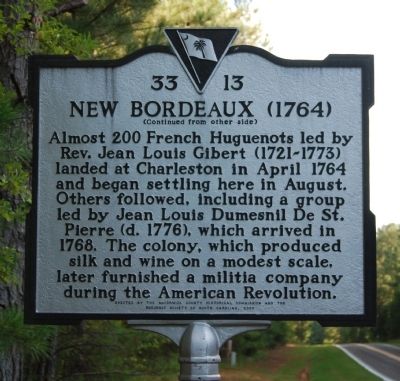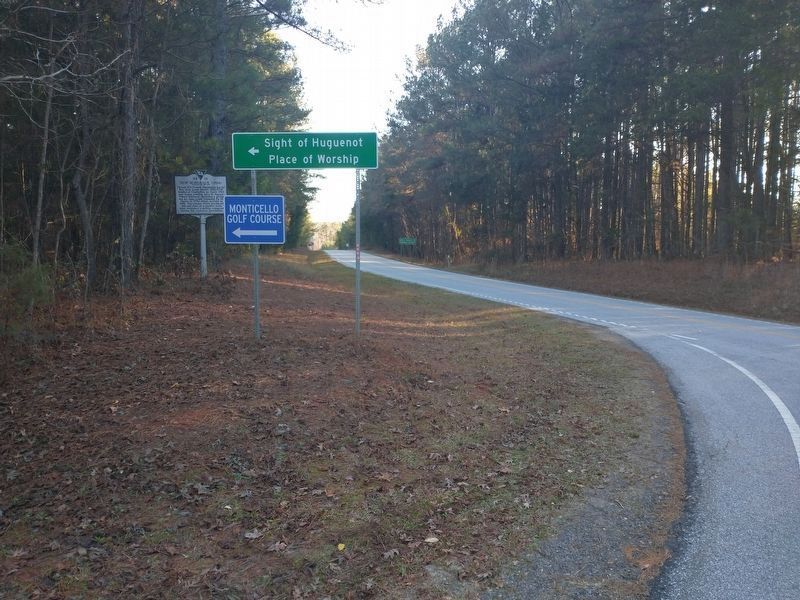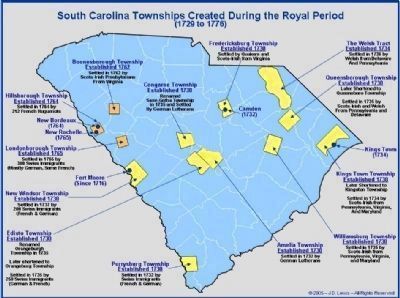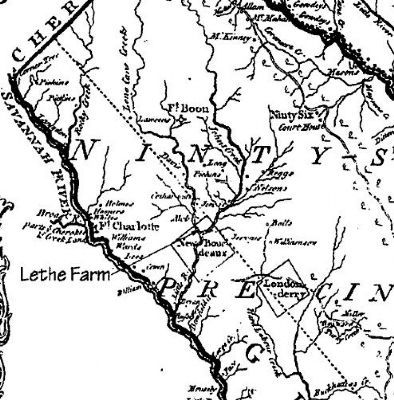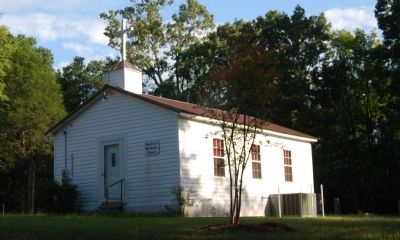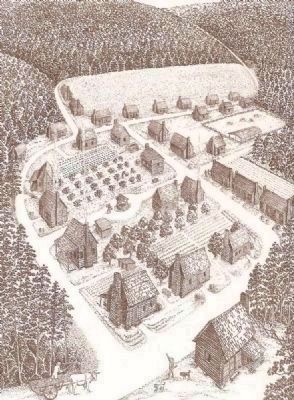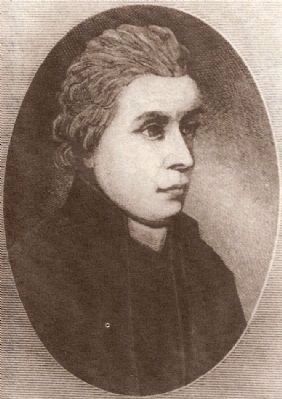Bordeaux in McCormick County, South Carolina — The American South (South Atlantic)
New Bordeaux (1764)
The town of New Bordeaux, the last of seven French Huguenot colonies founded in colonial S.C. and the only one in the upcountry, was established 1 mi. E in 1764. After Protestants fleeing religious persecution in France petitioned the British crown for land to create a permanent settlement in S.C., they received a 28,000-acre grant in the newly-formed Hillsborough Township.
Reverse:
Almost 200 French Huguenots led by Rev. Jean Louis Gibert (1721-1773) landed at Charleston in April 1764 and began settling here in August. Others followed, including a group led by Jean Louis Dumesnil De St. Pierre (d. 1776) which arrived in 1768. The colony, which produced silk and wine on a modest scale, later furnished a militia company during the American Revolution.
Erected 2000 by McCormick County Historical Commission and the Huguenot Society of South Carolina. (Marker Number 33-13.)
Topics and series. This historical marker is listed in these topic lists: Colonial Era • Patriots & Patriotism • Settlements & Settlers • War, US Revolutionary. In addition, it is included in the South Carolina, McCormick County Historical Commission series list. A significant historical month for this entry is April 1764.
Location. 33° 55.317′ N, 82° 24.8′ W. Marker is in Bordeaux, South Carolina, in McCormick County. Marker is on SC Road 33-7, on the right when traveling north. Marker is near the intersection of SC 33-7 and Huguenot Parkway. Touch for map. Marker is in this post office area: Mc Cormick SC 29835, United States of America. Touch for directions.
Other nearby markers. At least 8 other markers are within 3 miles of this marker, measured as the crow flies. New Bordeaux Worship Site (approx. 1.3 miles away); John De La Howe School Lethe Farm Trail (approx. 1.4 miles away); John De La Howe Forest (approx. 1.4 miles away); John De La Howe School Enterprise Market Program at "The Barn" (approx. 2.4 miles away); John De La Howe School (approx. 2.4 miles away); Andre Guillebeau (approx. 2.4 miles away); De La Howe Hall (approx. 2.4 miles away); John De La Howe / John De La Howe School (approx. 2˝ miles away). Touch for a list and map of all markers in Bordeaux.
Also see . . . The Royal Colony of South Carolina. There are many contradicting histories on what really led to the establishment of "Townships" in the interior of South Carolina immediately after the Crown took over the colony in 1729. (Submitted on November 24, 2009, by Brian Scott of Anderson, South Carolina.)
Additional commentary.
1. New Bordeaux
The town of New Bordeaux was planned and built in the design typical of a French village, the site on a gently rolling plane. Log homes were built on half acre lots in neat rows along narrow streets. On the home lots the Huguenot refugees planted fruit trees. Even now in springtime, the site reveals garlands of white blossoms of plum trees relevant to those French colonists of more than two centuries ago.
The village was an integral, self-sustaining community. For within the village there were the pastor, schoolteachers, and a medical doctor. There were skilled craftsmen: tailors, seamstresses, shoemaker, clog-maker, cabinet maker, coopers, wheelwrights, masons, carpenters, joiners, boatmen, vine dressers, and blacksmiths. Certainly all played a vital role in the welfare of the village. It should be emphasized that these Huguenots were some of France's finest professionals. Their professions, however, did not prevent these artisans from keeping their gardens and farm animals, and many pursued agricultural vocations. They all did any occupations in demand for that was, indeed, how they survived an prospered.
North of the village, on the southwest and southeast sides of Little River were the family, four-acre vineyard lots stretching along gentle slops toward the river. on these mini-farms the Huguenots developed grape vineyards. On the same lots they cultivated garden crops such as maize (Indian corn), potatoes, beans, and cabbage. And there were fruit trees scattered among the grape vineyards.
The saltus lands, that is the uncultivated lands, mostly forested in natural vegetation, surrounding the village in great abundance. These lands they used for grazing their cattle, sheep, horses, goats and hogs. And to the villagers these natural areas yielded a bonanza of resources such as fire wood, wild honey, berries, nuts, and any number of herbs for the cooking pot -- dandelion, asparagus, and plenty of garlic. The saltus lands were replete with wild game, and the streams with fish.
In New Bordeaux the Huguenots immediately organized a local form of government. The village governing council consisted of five members, the justice of peace, the minister, and the three officers of the village militia. It appears to have been a sort of branch of the provincial government in Charles Town with the local council directing reports to the colonial assembly. The Justice of the Peace was supplied with a copy of Simpson's Justices' Guide. The militia was an active and trained unit that served as a defense against Indian attacks, and during the American Revolution it served 100% as a patriot fighting force.
The first recorded marriage at New Bordeaux was that of Pierre Moragne, son of Pierre Moragne and Marie Paris, and Cecille Bayle, daughter of Jean Bayle and Marie Seyral, on July 16, 1765, "after the publication
of three banns." They were married by "Monsieur Boutiton, Minister of the Gospel," with Pierre Bellot and son Helie Bellot, and other persons of New Bordeaux as witnesses. (Source: The Making of McCormick County by Bobby F. Edmonds (1999), pgs 69-71.)
— Submitted December 8, 2009, by Brian Scott of Anderson, South Carolina.
2. New Bordeaux and Louis de Mesnil de St. Pierre
A third organized migration of Huguenots to South Carolina did make a determined effort to establish vineyards there. This was the community called New Bordeaux, whose origins may be traced to 1763, when some of the many Huguenots still living in London petitioned the board of trade for lands along the Savannah River, where they proposed "to apply themselves principally to the cultivation of vines and of silk." The petition was favorably received, and in 1764 some 132 French Protestants were sent to land lying near the Savannah River on Long Cane Creek, many miles above the Purrysburgh settlement. There, amidst the 26,000 acres of their grant, the french laid out there town of New Bordeaux; as the still-surviving map of the original survey shows, of the 800 acres of the town tract, 175 acres were reserved, "to be divided into 4-acre lots for vineyards and olive gardens." It may have been of these settlers' early efforts at winemaking that William Stork spoke in his Description of East Florida (1769), saying: "I have drank a red of the growth of that province [South Carolina] little inferior to Burgundy."
Whatever effort they made towards developing their vineyards was powerfully reinforced in 1768, when the community was joined by another migration of French Protestants under the leadership of Louis de Mesnil de St. Pierre. St. Pierre's original intention had been to take his people to Nov Scotia, but accident brought them to South Carolina instead. They could not have had viticulture in mind from the beginning: Nova Scotia was no place for the vine (though there are now vineyards and several small wineries there), and St. Pierre, a Norman, did not belong to the wine regions of France. Once in New Bordeaux, however, he devoted himself to viticulture with a determined zeal. The land, he wrote enthusiastically, "rose into gentle declivities, interspersed with delightful vales of small extent"; soil, water, climate, all were perfect for growing wine grapes, so that -- the conclusion is painfully familiar -- "we may venture to pronounce the success infallible."
When William Bartram travelled through South Carolina in June 1775, he was entertained at St. Pierre's residence, Orange Hill, which stood on a hill looking out over the Savannah River and into Georgia,
where winegrowing had been tried years before" Bartram found St. Pierre tending "a very thriving vineyard consisting of about five acres" at new Bordeaux. Since St. Pierre had been there since 1768, he was one of the very few of colonial vineyardists who actually persisted lone enough to have produced anything. Whether he was as hopeful in 1775 as he had been at the beginning of the decade we do not know. Bartram says nothing about St. Pierre's wine, if there was any. In any case, the Revolution put an end to the enterprise. St. Pierre joined the South Carolinian patriots in the war and was, according to a contemporary note, made "Lieutenant to a Small Fort in the back County where he lives upon his pay of 30 pounds a year." St. Pierre was killed on an expedition against the Indians and that 'untimely end," as a later memorialist wrote, "overturned the establishment in its infancy." New Bordeaux itself, never very flourishing, dwindled to the crossroads that it now is, where a marker records the site of the old Huguenot church. (Source: A History of Wine in America, Volume 1: From the Beginnings to Prohibition by Thomas Pinney (2007), pgs 95-100.)
— Submitted November 24, 2009, by Brian Scott of Anderson, South Carolina.
3. White Wine Recipe by St. Pierre
The best grapes used for making white wine were the Melier, the Beaume, and the Formentier. They must be gathered towards the close of the vintage, must be of the red sort, be trodden in the vat, which is reserved for white grapes, taking care to have the press well washed before the Mare of husks are pressed, lest it take a red tinge.
As white wines are subject to turn yellow when badly managed, to avoid this inconvenience, we must by no means suffer them to ferment. White grapes, in order to yield a very clear wine must be taken out of the vat almost as soon as put into it and be immediately put into the press, where indeed they are most commonly unloaded, directly as they come from the Vineyard, and put into casks, as they are pressed. (The Making of McCormick County by Bobby F. Edmonds (1999), pg 75.)
— Submitted November 24, 2009, by Brian Scott of Anderson, South Carolina.
4. Decline of New Bordeaux
In the years following the start of the Revolutionary War, the colony vanished. Reasons for this are unclear but they may have been economic. The war had disrupted normal life in South Carolina, where it had become a "civil war"-like conflict. This disruption affected commercial townships such as New Bordeaux which was founded specifically to produce wine and silk. The war disrupted trade, the life blood of towns such as New Bordeaux.
— Submitted September 21, 2008, by Brian Scott of Anderson, South Carolina.
Credits. This page was last revised on January 6, 2024. It was originally submitted on September 21, 2008, by Brian Scott of Anderson, South Carolina. This page has been viewed 6,622 times since then and 180 times this year. Last updated on January 3, 2012, by Charles Blakely of Pelzer, South Carolina. Photos: 1, 2. submitted on September 21, 2008, by Brian Scott of Anderson, South Carolina. 3. submitted on January 1, 2024, by Tom Bosse of Jefferson City, Tennessee. 4. submitted on November 21, 2009, by Brian Scott of Anderson, South Carolina. 5. submitted on November 23, 2009, by Brian Scott of Anderson, South Carolina. 6. submitted on September 21, 2008, by Brian Scott of Anderson, South Carolina. 7. submitted on December 8, 2009, by Brian Scott of Anderson, South Carolina. 8. submitted on December 6, 2009, by Brian Scott of Anderson, South Carolina. • Craig Swain was the editor who published this page.
